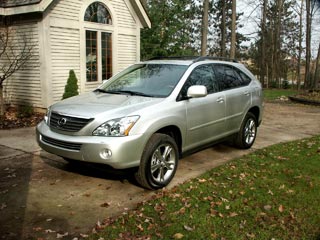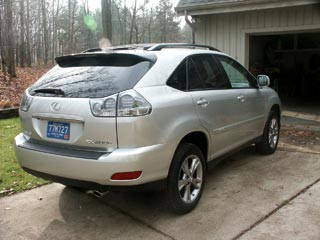
DRIVING DOWN THE ROAD
WITH CAREY RUSS
2007 Subaru Legacy 2.5 GT Spec B Sedan
What happens to a Subaru WRX when it grows up? It becomes a Subaru Legacy 2.5 GT Spec B.
The Spec B's introduction last year as a limited-production model must have been successful, as it returns for 2007 as a full production model. And it gets a few new features as well, most significantly the "Subaru Intelligent Drive" (hereafter referred to as SI-Drive) driver-configurable engine management and throttle control system, a six-speed manual gearbox, and a new audio system that plays MP3 and WMA CDs and has an auxiliary input jack for MP3 players or iPods. The interior is trimmed in sporty blue Alcantara¨, looking just like a WRX, and the car comes equipped with just about every option in the Subaru catalog.
The namesake 2.5-liter engine is a close relative to that in the WRX STi, and even closer relative to what's now found in the regular WRX. If its 2007-spec 243 horsepower and 241 lb-ft of torque ratings seem a little less than the previous 250 and 250, they aren't. Subaru has revised its power measurement calibration to be more conservative. It's the same engine found in the Legacy 2.5 GT Limited, but in the Spec B it's matched to a six-speed, not five-speed gearbox, and, fitting its performance flagship status, no automatic is available. All four wheels are driven all the time - this is a Subaru, after all.
External differences between the Spec B and Limited are minimal, but underneath there are significant suspension modifications. Aluminum control arms, a revised suspension tuning and Bilstein shocks, and 18-inch wheels with 45-profile tires give a firmer ride and sharpen the cornering response for a chassis tuning very similar to the standard WRX, not the take-no-prisoners STi.
I found that to be quite reasonable, and totally appropriate for the Spec B's wonderful engine and drivetrain during my week with one. It's very much a larger WRX in its setup and demeanor, but just a touch softer and with more soundproofing for a more civilized driving experience. It's not quite "luxury" in its appointment level, but no complaints there - too many one-time sports sedans have softened into "luxury semi-sport" over the years. Call the Legacy Spec B "sports-comfort" and get out of its way.
APPEARANCE: "Conservative" is the operative word in the Spec B's styling. Understated, it's the opposite of a WRX STi. Nothing about its looks loudly proclaims "high performance", but the hints are there for those who know. The functional hood scoop is lacking on the naturally-aspirated Legacy 2.5i models, but is shared with other 2.5 GTs, as they also share the turbo engine. It's small, and barely rises above the gently-sculpted hood line. The headlights and lower front bumper fascia are no different than on the regular Legacy models, and side sill extension is minimal. All Legacy sedan models share large taillights and twin exhausts. Larger, 18-inch, wheels with low-profile tires are most notable exterior difference between the Spec B and other GT models.
COMFORT: With blue suede-like Alcantara for its main seating surfaces, the Spec B's interior looks very WRX-like. There's nothing wrong with that, or with the comfort and support of its well-bolstered (in leather), power-adjustable and heated front sports seats, either. Add in the thick leather-rimmed MOMO steering wheel, aluminum-trimmed pedals (including footrest), moonroof, and bright, easily-visible backlit instruments, and the driver has a fine office from which to enjoy life on the road. The front passenger gets the same accommodation, while rear passengers get more space than in a smaller Impreza WRX. The rear seat is split 60/40 and folds for cargo ability if necessary. The Spec B's interior noise level is noticeably lower than the WRX's. The Subaru navigation system dominates the top of the center stack. It uses a simple touch-screen interface, which also incorporates fuel, trip, and maintenance reminder functions, and a handy calculator with metric-English conversion. The audio and climate systems are controlled separately, for further simplicity. The high-grade audio system includes a 6-disc in-dash CD changer that plays MP3 and WMA discs as well as commercial CDs, AM, FM, and, optionally, XM satellite radio, and there is a jack in the center console box for an MP3 player or iPod. There is a power point placed conveniently next to that jack. The Spec B's interior design may not be as luxurious as some similarly-priced European competitors, but it is much more functional.
SAFETY: The Subaru Legacy has received a "Top Safety Pick, Gold" rating from the IIHS and a five-star rating for frontal crash protection from NHTSA. Full-time all-wheel drive and, in the Spec B, powerful four-wheel ventilated antilock disc brakes and the Vehicle Dynamics Control system contribute to active safety, while the "Ring Frame Reinforced" body structure, incorporating a strong central safety cage and front and rear crumple zones, and standard dual-stage front, front side, and side curtain airbags contribute to passive safety.
RIDE AND HANDLING: If there are few external differences between the Spec B and its Legacy brethren, there are plenty of differences in its chassis. Although the basic architecture of all Legacys is the same, a unibody structure with a fully-independent suspension by MacPherson struts in front and a multilink system in the rear, the Spec B has stiffer springs with matching Bilstein shocks, and aluminum replaces steel for the most of the front and rear control arms to reduce unsprung weight and improve suspension response. The standard Legacy GT's 17-inch wheels are replaced with 18s, shod with low-profile summer performance tires. The steering is quickened a bit. The ride is firm, but not at all uncomfortable, in the classic sport-luxury sedan manner, and cornering behavior is very good. All-wheel drive, with a viscous-coupling locking center differential ensures optimum traction in all situations. The GT's limited-slip rear differential is upgraded to a Torsen unit for improved side-to-side torque distribution. The Spec B is the real deal in an all-wheel drive performance sedan.
PERFORMANCE: The Spec B uses the same WRX STi-derived 2.5-liter turbocharged and intercooled aluminum alloy twincam, 16-valve flat-four engine as the regular Legacy GT, with variable valve timing and 243 horsepower (at 6000 rpm) and 241 lb-ft of torque (at 3600 rpm). But instead of a five-speed manual or automatic transmission, it's hooked up to a six-speed manual, developed from the one in the STi. Closer ratios allow less of an rpm drop between shifts, improving acceleration. Acceleration is further aided by lower final drive gearing, but not so low as to seriously affect fuel economy. Its 0-60 time of just over five seconds would have put it in supercar territory not long ago. Power gets to the ground efficiently thanks to the all-wheel drive system. New this year, and shared with the Legacy 2.5 GT Limited and Outback 2.5 XT Limited models, is SI-Drive. SI-Drive is integrated into the engine control computer, and allows three driver-selectable engine modes. "I" (Intelligent) mode reduces power output about 20 percent and has a more relaxed throttle response. It's meant for use on low-traction surfaces, and in stop-and-go commute driving. "S" (Sport) mode is the default, with the same response as in 2006 models. It allows full power and a moderate throttle response. "S#" (Sport sharp) doesn't actually increase power, but feels like it as it remaps the electronic throttle for notably quicker response, so less right foot movement means more go. I kept the switch in that position most of the time, kept my foot in it as much as possible, and still managed a 21 mpg average for fuel consumption.
CONCLUSIONS: With its Legacy Spec B, Subaru has created a WRX for grownups.
SPECIFICATIONS
2007 Subaru Legacy 2.5 GT Spec B sedan
Base Price $ 33,995
Price As Tested $ 35,118
Engine Type horizontally-opposed turbocharged
and intercooled
dual overhead cam 4-cylinder
Engine Size 2.5 liters / 150 cu. in.
Horsepower 243 @ 6000 rpm
Torque (lb-ft) 241 @ 3600 rpm
Transmission 6-speed manual
Wheelbase / Length 105.1 in. / 186.2 in.
Curb Weight 3515 lbs.
Pounds Per Horsepower 14.5
Fuel Capacity 16.9 gal.
Fuel Requirement 91 octane premium unleaded gasoline
Tires 215/45 YR18 Bridgestone Potenza RE050A
Brakes, front/rear vented disc all around,
ABS, EBD, VDC standard
Suspension, front/rear independent MacPherson strut /
independent multi-link
Drivetrain longitudinal front engine,
all-wheel drive
PERFORMANCE
EPA Fuel Economy - miles per gallon
city / highway / observed 19 / 26 / 21
0 to 60 mph 5.1 sec
OPTIONS AND CHARGES
Wheel lock set $ 42
XM Satellite radio kit $ 456
Destination and delivery $ 625
 Driving the 2007 Mitsubishi Eclipse Spyder GT can be summed up in one word – FUN. This is not a family car; this is not even a practical car. This is the reward you give yourself for reaching a crowning achievement – professional or personal. It was Cyndi Lauper who sang Girls Just Wanna Have Fun; she must have been thinking about driving a convertible with the top down on a sunny day, the radio blaring and the feeling of freedom behind the wheel! I’ve just described the driving experience of a 2007 Mitsubishi Eclipse Spyder GT.
Driving the 2007 Mitsubishi Eclipse Spyder GT can be summed up in one word – FUN. This is not a family car; this is not even a practical car. This is the reward you give yourself for reaching a crowning achievement – professional or personal. It was Cyndi Lauper who sang Girls Just Wanna Have Fun; she must have been thinking about driving a convertible with the top down on a sunny day, the radio blaring and the feeling of freedom behind the wheel! I’ve just described the driving experience of a 2007 Mitsubishi Eclipse Spyder GT.












